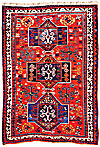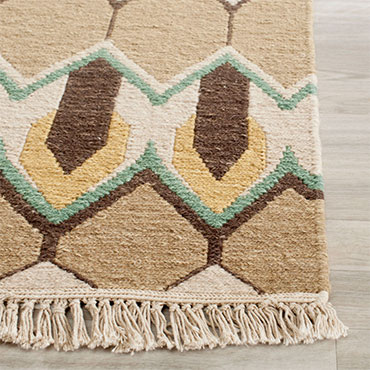

 Two major rug producing areas in Central Asia are the Caucasian and Turkoman
regions, which are justifiably famous for the high quality weaves of their
nomadic tribes. The Caucasus is a difficult mountain area between the Caspian
and Black Seas and, although the region now belongs to the USSR, it has been
home to many different tribes from Turkey, Armenia and Persia, all of which have
contributed to its heritage. Caucasian rugs produced in this area are strongly
geometric, with figures, birds and flowers reduced to straight lines. Turkestan
covers the region between the Caspian and north-western China, and the rugs made
by the various Afghani, Baluchi and Beshir tribesmen all have a similar
geometric style.
Two major rug producing areas in Central Asia are the Caucasian and Turkoman
regions, which are justifiably famous for the high quality weaves of their
nomadic tribes. The Caucasus is a difficult mountain area between the Caspian
and Black Seas and, although the region now belongs to the USSR, it has been
home to many different tribes from Turkey, Armenia and Persia, all of which have
contributed to its heritage. Caucasian rugs produced in this area are strongly
geometric, with figures, birds and flowers reduced to straight lines. Turkestan
covers the region between the Caspian and north-western China, and the rugs made
by the various Afghani, Baluchi and Beshir tribesmen all have a similar
geometric style.
With their distinctive bright colors, stylized childlike figures and elaborately decorated borders, Caucasian rugs are appealing and simple. Caucasian carpets work well in traditional and contemporary settings and are flexible enough for new or old homes. The simplicity of Caucasian rug patterns makes them easy to work with. Caucasian rugs are only available as scatter rugs: it is rare to find an example over 6x9ft. The opening of eastern Europe has made available some exciting Caucasian kilims .
Disclaimer: The information provided in this article is for general informational purposes only. While we strive to ensure the accuracy and reliability of the information presented, we make no warranties, express or implied, about the completeness, accuracy, reliability, suitability, or availability with respect to the content. Any reliance you place on such information is strictly at your own risk. We recommend consulting with professionals for specific advice tailored to your project’s needs, particularly regarding building codes, regulations, and product specifications.
Under no circumstances shall we be liable for any loss or damage, including without limitation, indirect or consequential loss or damage, arising from the use of, or reliance on, the information provided in this article.
